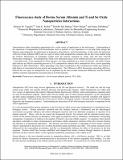| dc.contributor.author | Togashi, Denisio M. | |
| dc.contributor.author | Ryder, Alan G. | |
| dc.contributor.author | Mc Mahon, Deirdre | |
| dc.contributor.author | Dunne, Peter | |
| dc.contributor.author | McManus, James | |
| dc.date.accessioned | 2015-12-14T13:36:12Z | |
| dc.date.available | 2015-12-14T13:36:12Z | |
| dc.date.issued | 2007 | |
| dc.identifier.citation | D. M. Togashi, A. G. Ryder, D. M. Mahon, P. Dunne, and J. McManus, "Fluorescence study of Bovine Serum Albumin and Ti and Sn Oxide Nanoparticles Interactions.," in Diagnostic Optical Spectroscopy in Biomedicine IV, D. Schweitzer and M. Fitzmaurice, eds., Vol. 6628 of Proceedings of SPIE-OSA Biomedical Optics (Optical Society of America, 2007), paper 6628_61. DOI 10.1364/ECBO.2007.6628_61 | en_IE |
| dc.identifier.isbn | 9780819467720 | |
| dc.identifier.uri | http://hdl.handle.net/10379/5397 | |
| dc.description | Conference paper | en_IE |
| dc.description.abstract | Nanochemistry offers stimulating opportunities for a wide variety of applications in the biosciences. Understanding of the interaction of nanoparticles with biomolecules such as proteins is very important as it can help better design and fabricate nanocomposites for applications in diagnostics, drug delivery, and cell monitoring. In this work, the interaction of Bovine Serum Albumin (BSA) and two types of metal oxide nanoparticles (titanium and tin) have been studied using the intrinsic fluorescence of tryptophan residue from the proteins measured by steady state and time resolved fluorescence techniques. The nanoparticles which were fabricated using a novel synthetic process have average sizes of ~2 nm (SnO2) and ~6 nm (estimated for TiO2) and have very high solubilities in a variety of solvents. The Stern-Volmer plots indicate an effective quenching process by TiO2 nanoparticles whereas SnO2 nanoparticles have a lower quenching efficiency for BSA fluorescence. Static quenching is the major contribution in the overall process which may indicate a high degree of association between protein and nanoparticles. The difference in BSA fluorescence quenching efficiency between the two types of nanoparticles can be explained by the non-covalent interaction differences and the thermal stability of protein-nanoparticle associated species for both materials. | en_IE |
| dc.language.iso | en | en_IE |
| dc.publisher | The Optical Society | en_IE |
| dc.relation.ispartof | Proc SPIE Int. Soc. Opt. Eng. 6628 | en |
| dc.rights | Attribution-NonCommercial-NoDerivs 3.0 Ireland | |
| dc.rights.uri | https://creativecommons.org/licenses/by-nc-nd/3.0/ie/ | |
| dc.subject | Fluorescence | en_IE |
| dc.subject | Nanoparticles | en_IE |
| dc.subject | Bovine serum albumin | en_IE |
| dc.subject | Protein | en_IE |
| dc.subject | TiO2 | en_IE |
| dc.subject | SnO2 | en_IE |
| dc.title | Fluorescence study of bovine serum albumin and Ti and Sn Oxide nanoparticles interactions. | en_IE |
| dc.date.updated | 2015-12-11T16:51:30Z | |
| dc.identifier.doi | 10.1364/ECBO.2007.6628_61 | |
| dc.local.publishedsource | http://dx.doi.org/10.1364/ECBO.2007.6628_61 | en_IE |
| dc.description.peer-reviewed | Not peer reviewed | |
| dc.contributor.funder | |~|1267883|~| | |
| dc.internal.rssid | 1158804 | |
| dc.local.contact | Alan Ryder, School Of Chemistry, Room 213, Arts/Science Building, Nui Galway. 2943 Email: alan.ryder@nuigalway.ie | |
| dc.local.copyrightchecked | No | |
| dc.local.version | PUBLISHED | |
| nui.item.downloads | 399 | |


